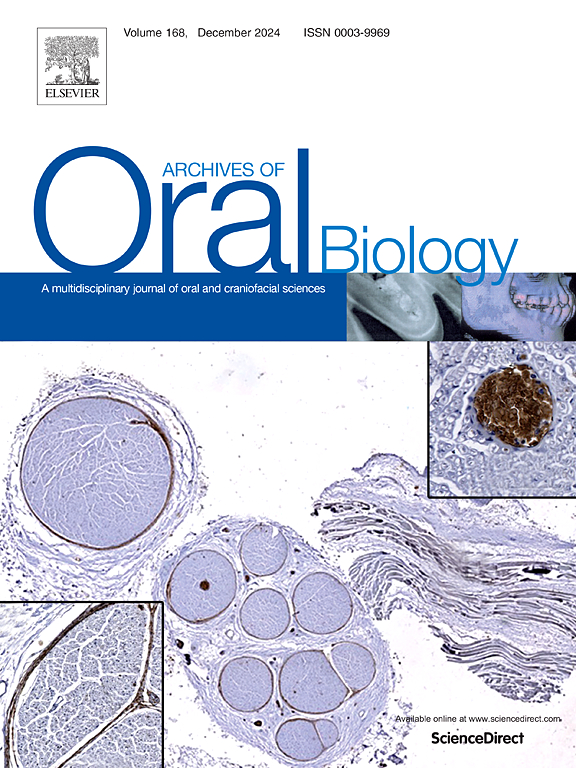含有白藜芦醇和氟化钠的新型抗氧化凝胶在获得性唾液膜存在下对牙本质侵蚀的保护作用:体外研究。
IF 2.1
4区 医学
Q2 DENTISTRY, ORAL SURGERY & MEDICINE
引用次数: 0
摘要
目的:研究含白藜芦醇实验凝胶在含1.23 %氟化钠(NaF)和不含1.23 %氟化钠(NaF)的情况下对牙本质侵蚀的保护作用及其与唾液膜的相互作用。设计:制备白藜芦醇含量为5 %或10 % (w/w)的凝胶,NaF添加量为1.23 % (w/w)。测定了总多酚含量(TPC)和抗氧化能力(ORAC)。人类牙质标本(n = 210)被分配到7个组(n = 30):消极的控制,氟化钠(1.23 %),5 %白藜芦醇,10 %白藜芦醇,5 %白藜芦醇+ 氟化钠,10 %白藜芦醇+ 氟化钠,和积极的控制(商业冲牙膏)。根据有无唾液膜进行分组(n = 15)。凝胶应用后,将标本提交至7天的侵蚀-磨蚀循环方案。结果包括表面损失(3D CLM),胶原酶后胶原降解,钙释放(原子吸收光谱法)和小管闭塞(CLM)。数据分析采用双因素方差分析和Tukey检验(α = 0.05)。结果:10 %白藜芦醇凝胶最高TPC和氧自由基吸收(p = 0.03),其次是10 %白藜芦醇+ 氟化钠(p = 0.013),而5 %白藜芦醇显示较低的值(p = 0.021)。所有组的唾液膜均显著降低了dsl侵蚀、dColl和CaR (p = 0.001)。联合配方的保护效果最好,G5和G6的dcl侵蚀(p = 0.002,0.004)、dcol (p = 0.014,0.021)和dsl总(p = 0.007,0.008)均较低,其中G6的CaR最低(p = 0.023)。结论:10% %白藜芦醇与NaF联合使用对牙本质侵蚀有较好的保护作用,且唾液膜的作用增强。本文章由计算机程序翻译,如有差异,请以英文原文为准。
Protective effect of a novel antioxidant gel containing resveratrol and sodium fluoride on dentin erosion in the presence of acquired salivary pellicle: An in vitro study
Objectives
This study aimed to evaluate the protective effect of experimental gels containing resveratrol, with or without 1.23 % sodium fluoride (NaF), and their interaction with the salivary pellicle on dentin erosion.
Design
Gels with 5 % or 10 % resveratrol (w/w) were prepared, with NaF added at 1.23 % (w/w). Total polyphenol content (TPC) and antioxidant capacity (ORAC) were determined. Human dentin specimens (n = 210) were allocated into seven groups (n = 30): negative control, NaF (1.23 %), 5 % resveratrol, 10 % resveratrol, 5 % resveratrol + NaF, 10 % resveratrol + NaF, and positive control (commercial anti-erosion toothpaste). Each group was divided according to the presence or absence of salivary pellicle (n = 15). After gel application, specimens were submitted to a 7-day erosive–abrasive cycling protocol. Outcomes included surface loss (3D CLM), collagen degradation after collagenase, calcium release (atomic absorption spectrometry), and tubule obliteration (CLM). Data were analyzed using two-way ANOVA and Tukey’s test (α = 0.05).
Results
The 10 % resveratrol gel had the highest TPC and ORAC (p = 0.03), followed by 10 % resveratrol + NaF (p = 0.013), whereas 5 % resveratrol showed lower values (p = 0.021). The salivary pellicle significantly reduced dSL-eroded, dColl, and CaR in all groups (p = 0.001). Combined formulations showed the greatest protection: G5 and G6 had lower dSL-eroded (p = 0.002, 0.004), dColl (p = 0.014, 0.021), and dSL-total (p = 0.007, 0.008), with G6 showing the lowest CaR (p = 0.023).
Conclusion
The combination of 10 % resveratrol and NaF effectively protected against dentin erosion, with salivary pellicle enhancing these effects.
求助全文
通过发布文献求助,成功后即可免费获取论文全文。
去求助
来源期刊

Archives of oral biology
医学-牙科与口腔外科
CiteScore
5.10
自引率
3.30%
发文量
177
审稿时长
26 days
期刊介绍:
Archives of Oral Biology is an international journal which aims to publish papers of the highest scientific quality in the oral and craniofacial sciences. The journal is particularly interested in research which advances knowledge in the mechanisms of craniofacial development and disease, including:
Cell and molecular biology
Molecular genetics
Immunology
Pathogenesis
Cellular microbiology
Embryology
Syndromology
Forensic dentistry
 求助内容:
求助内容: 应助结果提醒方式:
应助结果提醒方式:


